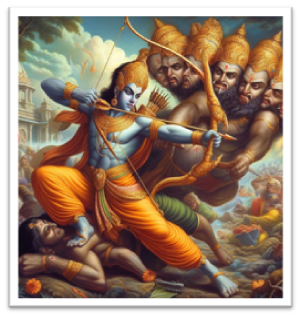Dussehra Festival Celebration in Bharat
Vijayadashami, also known as Dussehra, is a festival with several beliefs associated with it, which are significant from religious, cultural, and social perspectives. These beliefs reflect the deeper meaning and symbolism of the festival in Indian society. The festival is celebrated on the Dashami Tithi of the Shukla Paksha of the month of Ashwin, and is associated with both Lord Rama and Goddess Durga. The festival of Dussehra has been celebrated in Indian society for thousands of years, and it is observed in different ways across various ideologies in India. This festival not only reflects religious and mythological narratives but also incorporates social and cultural elements. Here are some of the major beliefs associated with Vijayadashami,
Ramayana and the Defeat of Ravana: The primary history of Vijayadashami is associated with the battle between Lord Rama and Ravana. According to the Ramayana, Lord Rama defeated the king of Lanka, Ravana, in a battle that lasted for 10 days. This battle concluded on the tenth day of the Shukla Paksha in the month of Ashwin, when Lord Rama killed Ravana and rescued Mata Sita. This day is celebrated as Vijayadashami, symbolizing the victory of good over evil.
Mahabharata and the Victory of the Pandavas: Vijayadashami is also associated with an important event in the Mahabharata. During their period of exile, the Pandavas, who were the rightful heirs to the throne of Hastinapura, were required to live incognito for a year as part of their conditions for exile. To ensure their weapons remained safe, they hid them in a Shami tree. After completing their exile, on the day of Dashami, they retrieved their weapons from the Shami tree and prepared for the battle that would eventually lead to their victory over the Kauravas in the Kurukshetra War. This retrieval of their weapons and subsequent victory is symbolically celebrated as Vijayadashami, representing the triumph of righteousness and the reclaiming of what is justly deserved.


Mahishasura slaying and Goddess Durga: Vijayadashami is also linked to the victory of Goddess Durga over Mahishasura. According to mythology, Mahishasura was a powerful demon who defeated the gods and took over heaven. The gods worshipped Goddess Durga, who then killed Mahishasura and freed the gods from his tyrannical rule. This battle
also lasted for 10 days and ended with Mahishasura’s death on the tenth day. This event is also celebrated as Vijayadashami, symbolizing the victory of power and righteousness.
Worship of Power and the Conclusion of Navratri: Vijayadashami marks the final day of Navratri, which is the culmination of nine days of worship of Goddess Durga. During Navratri, the Goddess is worshipped in various forms, and on Vijayadashami, the idols of the Goddess are immersed in water. This is seen as a symbol of the Goddess returning to her husband’s home (Mount Kailash) from her parental home.
Various Cultural and Regional Significances: The history and significance of Vijayadashami can vary slightly across different parts of India. In South India, it is celebrated as Ayudha Puja, where weapons and tools are worshipped. In West Bengal, it marks the conclusion of Durga Puja. In Gujarat, this day is the culmination of Navratri’s Garba and Dandiya Raas.
The history of Vijayadashami is rich with various religious and historic stories. It symbolizes the victory of good over evil, the triumph of power and righteousness, and the promotion of morality and dharma in society. This festival not only strengthens religious faith but also keeps alive the unity, morality, and cultural heritage in society.
Disclaimer: All the information given here is based on social and religious beliefs. This article is information collected from social media and internet for educational and non-profit purposes. Spicejet.Com does not confirm this. For this, please consult an expert.
Mr. Deepak Singh Bhandari (Assistant Manager – Ground Support Department)



